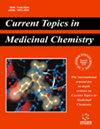植物化学物质:有望成为人类鼻病毒 14 型 3C 蛋白酶抑制剂的抗感冒策略
IF 2.9
4区 医学
Q3 CHEMISTRY, MEDICINAL
Current topics in medicinal chemistry
Pub Date : 2024-05-03
DOI:10.2174/0115680266308561240427065854
引用次数: 0
摘要
背景::人鼻病毒 3C 蛋白酶(HRV-3Cpro)在病毒增殖过程中起着至关重要的作用,使其成为抗病毒治疗的主要靶点。然而,有关确定 HRV-3Cpro 抑制剂的研究仍然有限。研究目的本研究有两个主要目标:第一,验证我们团队之前开发的终点比色测定法在确定 HRV-3Cpro 潜在抑制剂方面的有效性;第二,发现药用植物中可抑制该酶活性的植物化学物质。研究方法我们使用众所周知的 HRV-3Cpro 抑制剂 Rupintrivir 验证了比色测定法。随后,我们对 2532 种植物化学物质进行了两步硅学筛选,最终确定了八种活性化合物:芹菜素、肉豆蔻酚、绿原酸、山柰酚、木犀草素、槲皮素、迷迭香酸和芦丁。我们随后对这些候选化合物进行了体外评估。为了进一步研究最有希望的候选化合物,即肉毒酚和迷迭香酸的抑制潜力,我们进行了分子对接研究,分析它们与 HRV-3Cpro 的结合相互作用:利用著名的 HRV-3Cpro 抑制剂 Rupintrivir 验证比色法。随后,我们对 2532 种植物化学物质进行了两步硅学筛选,最终确定了八种活性化合物:芹菜素、肉豆蔻酚、绿原酸、山柰酚、木犀草素、槲皮素、迷迭香酸和芦丁。随后对这些候选化合物进行了体外评估。为了进一步研究最有希望的候选化合物(即肉毒酚和迷迭香酸)的抑制潜力,进行了分子对接研究,以分析它们与 HRV-3Cpro 的结合相互作用。结果我们之前开发的比色测定法能有效鉴定出选择性抑制 HRV-3Cpro 的化合物。卡诺索尔和迷迭香酸是有效的抑制剂,它们对体外 HRV-3Cpro 活性的抑制率超过 55%。我们的分析表明,卡诺索尔和迷迭香酸是通过竞争机制发挥抑制作用的。分子对接证实了它们与酶活性位点的竞争性结合。结论卡诺索和迷迭香酸在开发感冒治疗方面的潜力值得进一步研究。通过强调这些化合物是有效的 HRV-3Cpro 抑制剂,我们的研究为发现针对类似病原体蛋白酶的植物化学抑制剂提供了一种很有前景的方法。本文章由计算机程序翻译,如有差异,请以英文原文为准。
Phytochemicals: Promising Inhibitors of Human Rhinovirus Type 14 3C Protease as a Strategy to Fight the Common Cold
Background:: Human rhinovirus 3C protease (HRV-3Cpro) plays a crucial role in viral proliferation, establishing it as a prime target for antiviral therapy. However, research on identifying HRV-3Cpro inhibitors is still limited. Objective:: This study had two primary objectives: first, to validate the efficacy of an end-point colorimetric assay, previously developed by our team, for identifying potential inhibitors of HRV-3Cpro; and second, to discover phytochemicals in medicinal plants that inhibit the enzyme's activity. Methods:: Rupintrivir, a well-known inhibitor of HRV-3Cpro, was used to validate the colorimetric assay. Following this, we conducted a two-step in silico screening of 2532 phytochemicals, which led to the identification of eight active compounds: apigenin, carnosol, chlorogenic acid, kaempferol, luteolin, quercetin, rosmarinic acid, and rutin. We subsequently evaluated these candidates in vitro. To further investigate the inhibitory potential of the most promising candidates, namely, carnosol and rosmarinic acid, molecular docking studies were performed to analyze their binding interactions with HRV-3Cpro. method: : Rupintrivir, a well-known inhibitor of HRV-3Cpro, was utilized to validate the colorimetric assay. Following this, we conducted a two-step in silico screening of 2532 phytochemicals, which led to the identification of eight active compounds: apigenin, carnosol, chlorogenic acid, kaempferol, luteolin, quercetin, rosmarinic acid, and rutin. These candidates were subsequently evaluated in vitro. To further investigate the inhibitory potential of the most promising candidates, viz. carnosol and rosmarinic acid, molecular docking studies were performed to analyze their binding interactions with HRV-3Cpro. Results:: The colorimetric assay we previously developed is effective in identifying compounds that selectively inhibit HRV-3Cpro. Carnosol and rosmarinic acid emerged as potent inhibitors, inhibiting HRV-3Cpro activity in vitro by over 55%. Our analysis indicated that carnosol and rosmarinic acid exert their inhibitory effects through a competitive mechanism. Molecular docking confirmed their competitive binding to the enzyme's active site. Conclusion:: Carnosol and rosmarinic acid warrant additional investigation for their potential in the development of cold treatment. By highlighting these compounds as effective HRV-3Cpro inhibitors, our study presents a promising approach for discovering phytochemical inhibitors against proteases from similar pathogens.
求助全文
通过发布文献求助,成功后即可免费获取论文全文。
去求助
来源期刊
CiteScore
6.40
自引率
2.90%
发文量
186
审稿时长
3-8 weeks
期刊介绍:
Current Topics in Medicinal Chemistry is a forum for the review of areas of keen and topical interest to medicinal chemists and others in the allied disciplines. Each issue is solely devoted to a specific topic, containing six to nine reviews, which provide the reader a comprehensive survey of that area. A Guest Editor who is an expert in the topic under review, will assemble each issue. The scope of Current Topics in Medicinal Chemistry will cover all areas of medicinal chemistry, including current developments in rational drug design, synthetic chemistry, bioorganic chemistry, high-throughput screening, combinatorial chemistry, compound diversity measurements, drug absorption, drug distribution, metabolism, new and emerging drug targets, natural products, pharmacogenomics, and structure-activity relationships. Medicinal chemistry is a rapidly maturing discipline. The study of how structure and function are related is absolutely essential to understanding the molecular basis of life. Current Topics in Medicinal Chemistry aims to contribute to the growth of scientific knowledge and insight, and facilitate the discovery and development of new therapeutic agents to treat debilitating human disorders. The journal is essential for every medicinal chemist who wishes to be kept informed and up-to-date with the latest and most important advances.

 求助内容:
求助内容: 应助结果提醒方式:
应助结果提醒方式:


